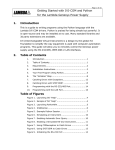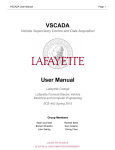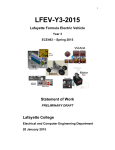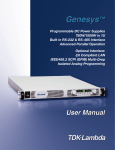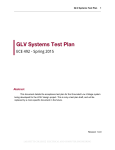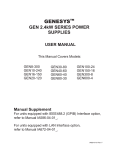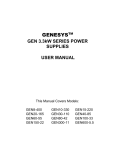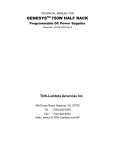Download D002: User Manual - Sites at Lafayette
Transcript
User Manual ECE 492 – Spring 2014 Latest Revision: 27 March 2014 Prepared by: Robert Lombino Abstract This document describes the system interface from a user’s perspective and gives information on how to manage the system. Table of Contents INTRODUCTION 2 SAFETY 2 IDENTIFICATION OF SYSTEM COMPONENTS 2 PACK 2 CHARGER 3 CONNECTORS 3 CABLES 3 DISPLAY 4 SYSTEM OPERATION 4 DISCHARGE 4 1. PACK STATUS AND SET-UP 4 2. DISCHARGE 5 3. TEAR-DOWN 5 CHARGE 6 1. PACK STATUS AND SET-UP 6 2. CHARGING 6 3. CHARGE TERMINATION 7 SERVICE 7 CHARGING FUSES 7 DISCHARGING FUSE 8 USER MANUAL 2 Introduction The LFEV-ESCM as delivered in 2014 consists of a 7-cell electrochemical accumulator pack designed to provide energy to an electric Formula SAE vehicle, and a charger to replenish the energy of the accumulator. This user's manual covers the normal operation and basic troubleshooting of the system. Safety As with all electrical devices, safety is of primary concern when handling and operating the LFEV-ESCM system. Please note the following safety precautions: Wear safety glasses at all times when operating or maintaining the system. The accumulator cells store a large amount of energy, and careless behavior can cause this energy to dissipate extremely quickly in the form of electric shock, arc, explosion, or other violent and potentially destructive ways. This energy discharge can cause collateral damage and personal injury, including shock, and burns. Beware of pinch points on the pack, including hinged access panels and connector junctions. The pack weighs in excess of 50 pounds (22 kg). Because of the size and shape, it should only be moved by two people. Certain pack components may become hot during operation. This is expected and anticipated as part of the design. These components are not normally directly accessible, though the exterior of the pack may still become warm as a result. These components are marked with yellow thermally-activated labels that display "HOT" in red letters when the surface temperature of the component is (temp) or higher. Identification of System Components Pack The accumulator pack (hereafter, "pack") contains seven LiFePo4 battery cells. Each cell has a nominal voltage of 3.2 volts and a nominal capacity of 60 amp-hours, for an overall pack voltage of 22.4 volts. The pack also contains two charging fuses and one discharge fuse to protect the pack in case of accidental short circuit. Accumulator isolation relays (hereafter "AIRs") prevent unauthorized discharge of the pack. The charging and discharging of the pack is completely self-managed and monitored by an integrated, low-power industrial computer system. Charger The TDK-Lambda GENH30-25 is an off-the-shelf, UL-listed commercial power supply which produces up to 30 volts DC at up to 25 amps. Its parameters can be set directly using the front panel controls, or remotely using an RS-232 link. Basic operation as pertinent to the LFEV system will be outlined in this user's manual. Complete, detailed operating instructions and product specifications may be found in the GENESYSTM 750W HALF RACK Technical Manual, available at http://www.us.tdk-lambda.com/hp/pdfs/Product_manuals/835075002.pdf (as of 2 May 2014) The pigtailattached to the rear of the charger provides a convenient connection for the charging cable. This pigtail is semi-permanently attached and should not be removed except as required in the event of system repair or maintenance. See the SMM for more information about how to properly remove the pigtail. Connectors The following connectors are present on the pack: High-current discharge connectors: These are the large blue connectors located on the top of the pack at each end. The positive (+) and negative (-) terminals are marked. Safety Loop connectors (2): These are the white, 4-pin connectors located on the top of the pack at each end. The connectors are electrically identical and either one may be used when a reference to "safety loop" is made in this manual. RS-485 connector: This is the white, 6-pin connector on the top of the pack at the negative end. This connector provides an RS-485 link to a data acquisition system (not provided) when installed in the Formula SAE vehicle. Charging connector: This is the multi-colored Anderson PowerPole connector located on the top of the pack at the negative end. This connector is used to provide charging current to the pack and to communicate with the charger. Cables The following cables are included with the system: Charging Cable: This is a 2+3 conductor cable assembly which provides both the charging current path and the RS-232 communication path from the charger to the pack. This cable is identified by Anderson PowerPole connectors on both ends. PIC-Kit3 In-Circuit Programmer: This is used to load firmware onto the BMS boards. It is not used during normal operation. For further details refer to the System Maintenance Manual. USER MANUAL 4 RS-485 to PC adapter: This cable consists of two components. The first is a commercially available RS-485 to USB adapter, available from the ECE Department Lab Coordinator. The second is a DB-9 to 6-pin cable. The following cables are not included with the system because their exact configuration varies based on the application. The system maintenance manual gives detailed information about electrical specifications and pinouts of these connectors Discharging cables: These cables connect the pack to other packs and/or a load. They attach to the high-current discharge connectors. Display The pack includes a 20x4-character LCD display which indicates the pack status. System Operation IMPORTANT: Before operating the system, note the safety precautions in the front of this manual. Discharge Discharge is defined as any procedure for which the AIRs are closed and current is drawn from the discharge connectors. The following steps outline the discharge procedure. 1. Pack Status and Set-up To ensure that the pack is in an appropriate state for discharging, two conditions must be met: The pack power LED must be lit. The LCD should not display any error code. If the LED is out or the LCD displays an error code, see the "Troubleshooting" section before proceeding. Once the pack is in the correct state, connections should be made as follows: 1. Attach the pack to the safety loop using both safety loop connectors by pushing each plug straight in until it clicks. As the name implies, the loop must be closed for proper operation. If only one safety loop connector is used, the other connector must be filled with a "dummy" plug to close the safety loop. 2. Attach the RS-485 communication link to the pack, if this link is used, by pushing the plug straight in until it clicks. This connection serves for data acquisition purposes only. The pack will be able to discharge with or without this connection. 3. With the load switched off, attach the load to the pack using both high-current discharge connectors by pushing each plug straight on, then rotating clockwise until it clicks. 2. Discharge The system is now ready to be discharged. 1. Activate the safety loop. The AIRs should close with an audible click. 2. Connect the load to AC mains, if applicable, and switch on the load. The current drawn through the pack will be displayed on the LCD screen. 3. In case of emergency, stop discharge immediately by de-activating the safety loop. 4. The pack will continue to discharge until it reaches 0% state-of-charge as determined by the PacMan, or until an error condition occurs in the pack, such as low voltage, high temperature, etc. 5. If an error occurs, the safety loop will open and the discharge will stop. The safety loop will not be closed until the error condition is resolved. See the "Troubleshooting" section for error code descriptions. 3. Tear-down 1. Switch off the load. The high-current connectors must not be disconnected while the pack is under load. 2. De-activate the safety loop. The AIRs should not be opened under load except in emergency situations, i.e. the safety loop is tripped. 3. Disconnect the safety loop connectors, the RS-485 link, and the discharge connectors. 4. Disconnect the load from AC mains, if applicable. 5. Store the pack safely and securely. USER MANUAL 6 Charge The preferred charger is the TDK-Lambda GENH30-25 supplied with the system. The pack can communicate with this charger to regulate charging voltage and current. An alternate power supply may instead be used to charge the pack, provided that it meets the voltage and current requirements of the pack. For more information about using alternate chargers, see the System Maintenance Manual. 1. Pack Status and Set-up IMPORTANT: The pack cannot be simultaneously charged and discharged. Connecting the charging cable will immediately open the safety loop. To ensure that the pack is in an appropriate state for charging, two conditions must be met: The pack power LED must be lit. The LCD should not display any error code. If the LED is out or the LCD displays an error code, see the "Troubleshooting" section before proceeding. Once the pack is in the correct state, connections should be made as follows: 1. Attach the AC mains cable to the charger, and plug it into a grounded, 120VAC wall socket. 2. Turn on the AC mains power switch located on the charger. 3. Attach the RS-485 communication link to the pack, if this link is used, by pushing the plug straight in until it clicks. This connection serves for data acquisition purposes only. The pack will be able to charge with or without this connection. 4. Attach the charge cable to the charger by pushing one end of the charging cable straight into the charger pigtail socket until it clicks. 5. Attach the other end of the charge cable to the pack by pushing the connector straight into the socket until it clicks. 2. Charging 1. The pack will automatically detect the presence of the charger. In case the pack has been depleted so far that the integrated computer has shut down, the computer must boot before charging can begin. a. If the GENH30-25 charger is used, the pack will configure the charger with the proper voltage and current limits, and switch it on automatically. b. If another charger is used, its output must be configured and enabled manually. The pack computer will check the output voltage of the charger. If the voltage is within the correct range, the charge relays will close and the pack will begin to charge. This is indicated on the LCD screen by the word "Charging" and the charge current readout in amps. If the voltage is not appropriate for the pack configuration, an error will be indicated on the LCD screen and the pack will not charge. As soon as voltage is present at the charger inputs, the pack cooling fan will turn on. This fan operates only during pack charging, to exhaust heat produced by the cell-balancing circuitry. It is a convenient indicator of the presence of charging voltage at the pack connector. 3. Charge Termination 1. When the system determines that the pack is fully charged, the charging relays will open and "Charging Complete" will display on the LCD. The flow of current to the cells will be stopped, but the fan might remain in operation. a. If the GENH30-25 charger is used, the pack will switch off the charger output, so the fan will stop. b. If another charger is used, its output will not be switched off by the pack, so the fan will remain in operation. If the charger is disconnected at any time, charge will be terminated. If an error condition occurs in the pack, the error will be displayed on the LCD and charge will be terminated. Once the error has been corrected, charging will resume automatically. Service The system is carefully engineered for performance, efficiency, and safety. As such, it is highly complex, and major repair or disassembly requires a thorough understanding of design principles. Nevertheless, there are user-serviceable parts which can be replaced without a large effort and without requiring extensive system knowledge. Charging Fuses These fuses protect the charging circuit. If a blown charging fuse is suspected, perform these steps: USER MANUAL 8 1. Remove the end cap from the fuse holder by rotating counterclockwise, then pulling straight out. The fuse will come out with the cap. a. If the fuse cartridge is broken or damaged, it is possible that small shards of material are lodged in the holder. In this case, the entire fuse holder should be replaced. See the SMM for instructions. 2. The fuse is a 30-amp, 3AB ceramic-tube type cartridge fuse. Because the fuse element cannot be visually inspected, the fuse must be continuity-tested with a multimeter. a. If the fuse reads <1 ohm, it is still good. b. If the fuse reads >1 ohm, it is blown and must be replaced. 3. If the fuse is blown, it must be replaced only by Littelfuse part number 0505030.MXP or equivalent. This fuse has a 500V, 20kA DC interrupt rating which is necessary to ensure full protection of the system. IMPORTANT: Although physically interchangeable, standard 3AG glass-tube fuses are NOT acceptable substitutes in this system. 4. If the fuse is good, re-install it by placing it in the end cap and replacing the end cap in the holder. The fuse can be inserted either direction. The other fuse should be inspected in the same fashion. Discharging Fuse This fuse protects the primary tractive system current path. If a blown discharging fuse is suspected, perform these steps: 1. Face the pack so the negative terminal is on your right. Remove the side enclosure panel or Lexan display panel. The fuse holder is accessible only from this side. 2. Remove the two bolts holding the fuse to the holder using a (size) wrench. Take care to keep track of the bolts and washers. 3. The fuse is a 200-amp Class T fuse. Because the fuse element cannot be visually inspected, the fuse must be continuity-tested with a multimeter. a. If the fuse reads <1 ohm, it is still good. b. If the fuse reads >1 ohm, it is blown and must be replaced. If the fuse is blown, it must be replaced only by Mersen part number A3T200. This fuse has a 160V, 50kA DC interrupt rating which is necessary to ensure full protection of the system. If the fuse is good, re-install it by attaching it to the fuse holder using the bolts and washers removed in Step 2.













